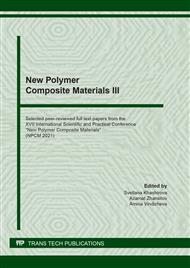p.239
p.245
p.253
p.262
p.269
p.275
p.281
p.287
p.292
Modification of the Hygroscopic Properties of Textile Materials Containing Polyurethane Threads
Abstract:
The article discusses the influence of the presence of polyurethane (elastomeric) threads in the composition of a textile material on the effect of plasma modification of hygroscopic properties. The objects of the study were textile (knitted) fabrics based on cotton fibers with the addition of Dorlastan threads. The samples were processed in the plasma of a high-frequency capacitive discharge at a reduced pressure, as the plasma-forming gas was used air. Experiments have shown that the water absorption of the samples after plasma treatment is increased by an average of 1.5 times. The presence of Dorlastan thread does not significantly affect the result of the plasma modification, since the samples are completely immersed in water and the elastomeric threads do not limit the water absorption of its cotton component. The degree of capillary rise, on the contrary, depends on the presence of polyurethane threads. In samples made of 100% cotton, the increase occurs up to 190-. According to these samples, polyurethane threads prevent the capillarity of water by about 4 times. Kinetic curves of water absorption are given. The results suggest that other processing treatments are required to render the polyurethane threads hydrophilicity by plasma treatment. This should be considered in the development of plasma methods for treating textile materials, including in terms of matrix for composite materials.
Info:
Periodical:
Pages:
269-274
Citation:
Online since:
September 2021
Price:
Сopyright:
© 2021 Trans Tech Publications Ltd. All Rights Reserved
Share:
Citation:


